EGB100 Engineering Sustainability - Cambodia Solid Waste Report
VerifiedAdded on 2023/06/14
|6
|1373
|323
Report
AI Summary
This report assesses the feasibility of solid waste management (SWM) in Cambodia, covering domestic, industrial, and hospital waste. It discusses the legal framework, strategic plans, and institutional responsibilities for hazardous waste management. Key issues include waste collection, illegal dumping, and the lack of sanitary landfills, leading to environmental and public health concerns. Positively, the organic nature of much waste allows for composting, aligning with the 'reduce, reuse, and recycle' (3R) strategy. Mitigation plans involve promoting 3R practices and identifying potential waste streams for better waste management at the source. The report highlights the importance of regulating SWM, implementing national strategies, and designing effective waste management sites to reduce pollution and protect human health. Desklib provides access to similar solved assignments and study tools for students.
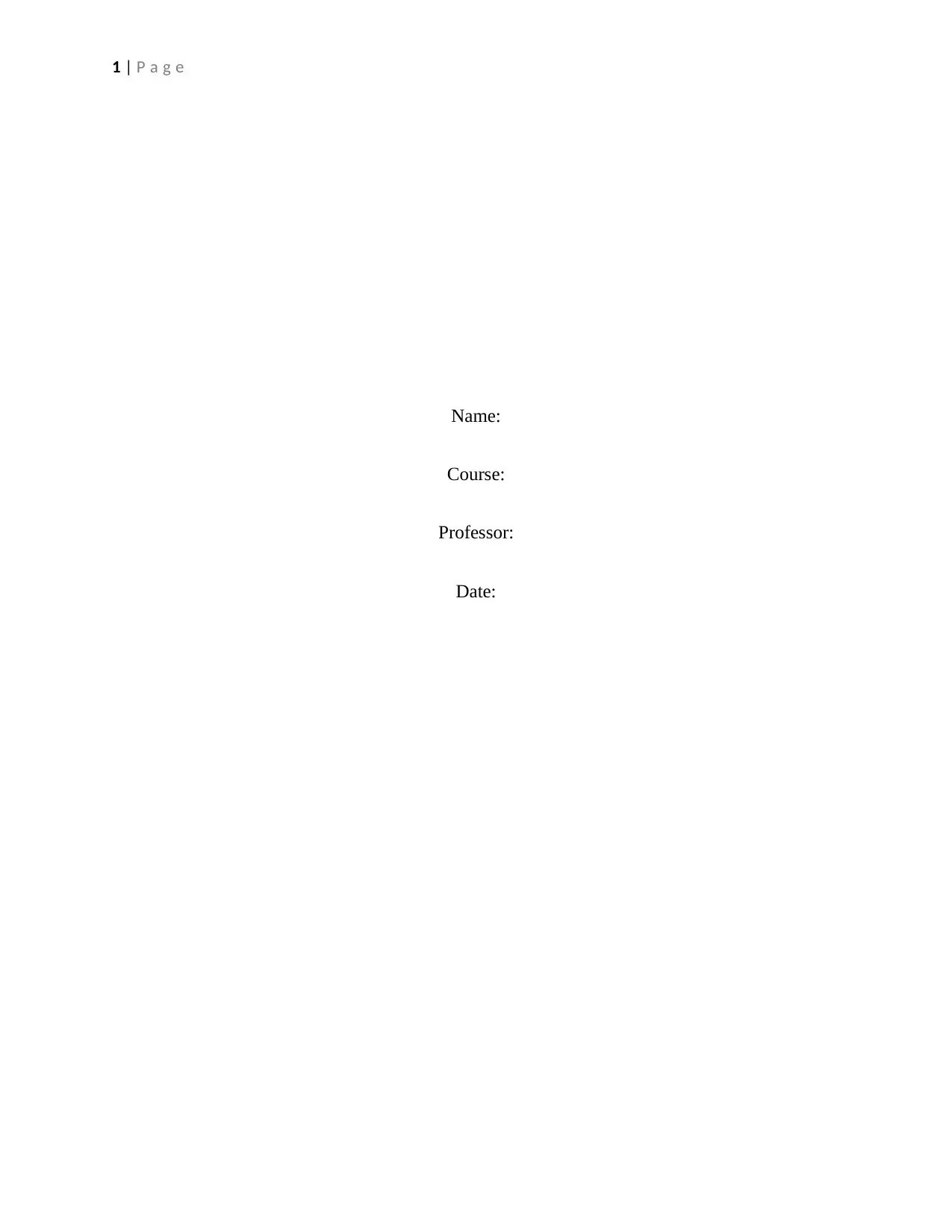
1 | P a g e
Name:
Course:
Professor:
Date:
Name:
Course:
Professor:
Date:
Paraphrase This Document
Need a fresh take? Get an instant paraphrase of this document with our AI Paraphraser
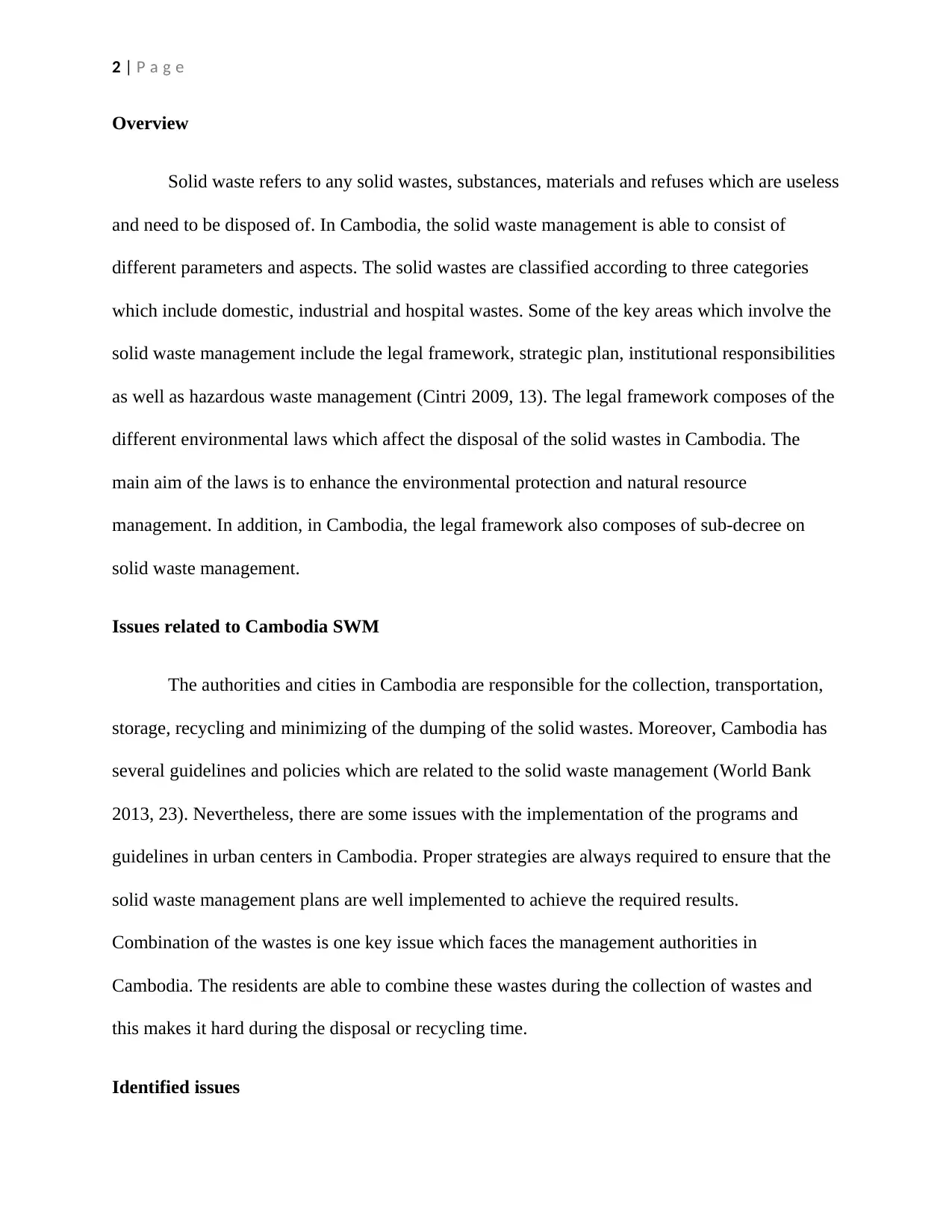
2 | P a g e
Overview
Solid waste refers to any solid wastes, substances, materials and refuses which are useless
and need to be disposed of. In Cambodia, the solid waste management is able to consist of
different parameters and aspects. The solid wastes are classified according to three categories
which include domestic, industrial and hospital wastes. Some of the key areas which involve the
solid waste management include the legal framework, strategic plan, institutional responsibilities
as well as hazardous waste management (Cintri 2009, 13). The legal framework composes of the
different environmental laws which affect the disposal of the solid wastes in Cambodia. The
main aim of the laws is to enhance the environmental protection and natural resource
management. In addition, in Cambodia, the legal framework also composes of sub-decree on
solid waste management.
Issues related to Cambodia SWM
The authorities and cities in Cambodia are responsible for the collection, transportation,
storage, recycling and minimizing of the dumping of the solid wastes. Moreover, Cambodia has
several guidelines and policies which are related to the solid waste management (World Bank
2013, 23). Nevertheless, there are some issues with the implementation of the programs and
guidelines in urban centers in Cambodia. Proper strategies are always required to ensure that the
solid waste management plans are well implemented to achieve the required results.
Combination of the wastes is one key issue which faces the management authorities in
Cambodia. The residents are able to combine these wastes during the collection of wastes and
this makes it hard during the disposal or recycling time.
Identified issues
Overview
Solid waste refers to any solid wastes, substances, materials and refuses which are useless
and need to be disposed of. In Cambodia, the solid waste management is able to consist of
different parameters and aspects. The solid wastes are classified according to three categories
which include domestic, industrial and hospital wastes. Some of the key areas which involve the
solid waste management include the legal framework, strategic plan, institutional responsibilities
as well as hazardous waste management (Cintri 2009, 13). The legal framework composes of the
different environmental laws which affect the disposal of the solid wastes in Cambodia. The
main aim of the laws is to enhance the environmental protection and natural resource
management. In addition, in Cambodia, the legal framework also composes of sub-decree on
solid waste management.
Issues related to Cambodia SWM
The authorities and cities in Cambodia are responsible for the collection, transportation,
storage, recycling and minimizing of the dumping of the solid wastes. Moreover, Cambodia has
several guidelines and policies which are related to the solid waste management (World Bank
2013, 23). Nevertheless, there are some issues with the implementation of the programs and
guidelines in urban centers in Cambodia. Proper strategies are always required to ensure that the
solid waste management plans are well implemented to achieve the required results.
Combination of the wastes is one key issue which faces the management authorities in
Cambodia. The residents are able to combine these wastes during the collection of wastes and
this makes it hard during the disposal or recycling time.
Identified issues
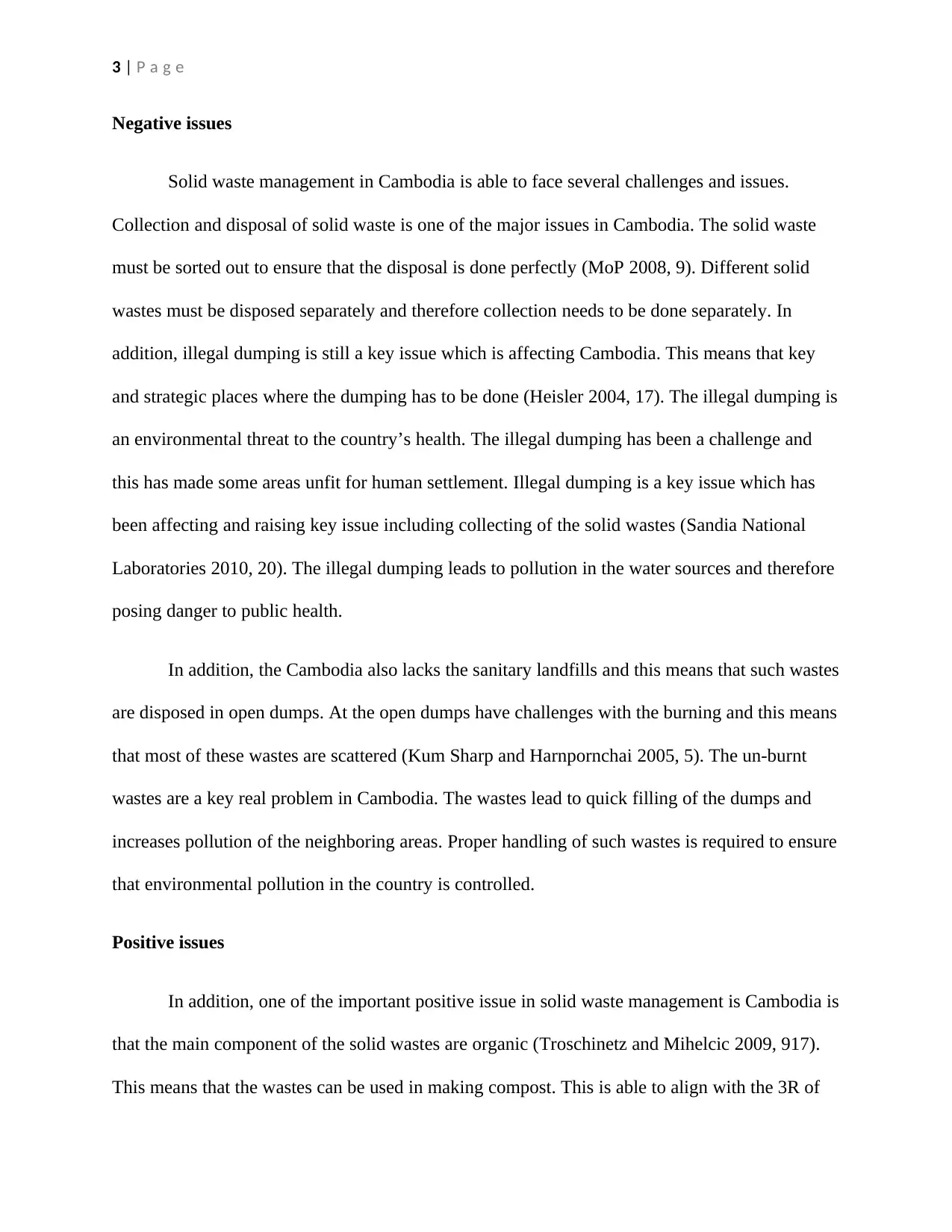
3 | P a g e
Negative issues
Solid waste management in Cambodia is able to face several challenges and issues.
Collection and disposal of solid waste is one of the major issues in Cambodia. The solid waste
must be sorted out to ensure that the disposal is done perfectly (MoP 2008, 9). Different solid
wastes must be disposed separately and therefore collection needs to be done separately. In
addition, illegal dumping is still a key issue which is affecting Cambodia. This means that key
and strategic places where the dumping has to be done (Heisler 2004, 17). The illegal dumping is
an environmental threat to the country’s health. The illegal dumping has been a challenge and
this has made some areas unfit for human settlement. Illegal dumping is a key issue which has
been affecting and raising key issue including collecting of the solid wastes (Sandia National
Laboratories 2010, 20). The illegal dumping leads to pollution in the water sources and therefore
posing danger to public health.
In addition, the Cambodia also lacks the sanitary landfills and this means that such wastes
are disposed in open dumps. At the open dumps have challenges with the burning and this means
that most of these wastes are scattered (Kum Sharp and Harnpornchai 2005, 5). The un-burnt
wastes are a key real problem in Cambodia. The wastes lead to quick filling of the dumps and
increases pollution of the neighboring areas. Proper handling of such wastes is required to ensure
that environmental pollution in the country is controlled.
Positive issues
In addition, one of the important positive issue in solid waste management is Cambodia is
that the main component of the solid wastes are organic (Troschinetz and Mihelcic 2009, 917).
This means that the wastes can be used in making compost. This is able to align with the 3R of
Negative issues
Solid waste management in Cambodia is able to face several challenges and issues.
Collection and disposal of solid waste is one of the major issues in Cambodia. The solid waste
must be sorted out to ensure that the disposal is done perfectly (MoP 2008, 9). Different solid
wastes must be disposed separately and therefore collection needs to be done separately. In
addition, illegal dumping is still a key issue which is affecting Cambodia. This means that key
and strategic places where the dumping has to be done (Heisler 2004, 17). The illegal dumping is
an environmental threat to the country’s health. The illegal dumping has been a challenge and
this has made some areas unfit for human settlement. Illegal dumping is a key issue which has
been affecting and raising key issue including collecting of the solid wastes (Sandia National
Laboratories 2010, 20). The illegal dumping leads to pollution in the water sources and therefore
posing danger to public health.
In addition, the Cambodia also lacks the sanitary landfills and this means that such wastes
are disposed in open dumps. At the open dumps have challenges with the burning and this means
that most of these wastes are scattered (Kum Sharp and Harnpornchai 2005, 5). The un-burnt
wastes are a key real problem in Cambodia. The wastes lead to quick filling of the dumps and
increases pollution of the neighboring areas. Proper handling of such wastes is required to ensure
that environmental pollution in the country is controlled.
Positive issues
In addition, one of the important positive issue in solid waste management is Cambodia is
that the main component of the solid wastes are organic (Troschinetz and Mihelcic 2009, 917).
This means that the wastes can be used in making compost. This is able to align with the 3R of
⊘ This is a preview!⊘
Do you want full access?
Subscribe today to unlock all pages.

Trusted by 1+ million students worldwide
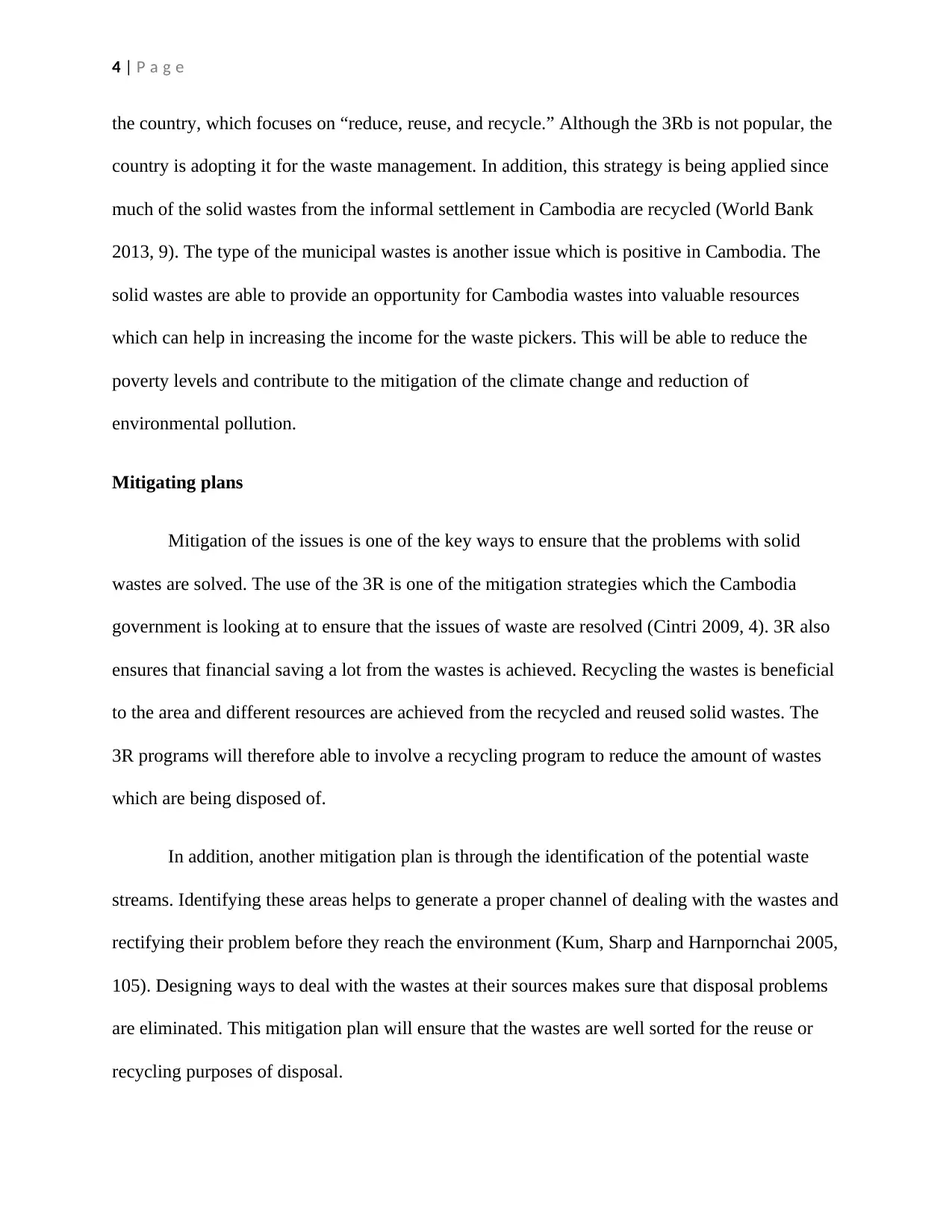
4 | P a g e
the country, which focuses on “reduce, reuse, and recycle.” Although the 3Rb is not popular, the
country is adopting it for the waste management. In addition, this strategy is being applied since
much of the solid wastes from the informal settlement in Cambodia are recycled (World Bank
2013, 9). The type of the municipal wastes is another issue which is positive in Cambodia. The
solid wastes are able to provide an opportunity for Cambodia wastes into valuable resources
which can help in increasing the income for the waste pickers. This will be able to reduce the
poverty levels and contribute to the mitigation of the climate change and reduction of
environmental pollution.
Mitigating plans
Mitigation of the issues is one of the key ways to ensure that the problems with solid
wastes are solved. The use of the 3R is one of the mitigation strategies which the Cambodia
government is looking at to ensure that the issues of waste are resolved (Cintri 2009, 4). 3R also
ensures that financial saving a lot from the wastes is achieved. Recycling the wastes is beneficial
to the area and different resources are achieved from the recycled and reused solid wastes. The
3R programs will therefore able to involve a recycling program to reduce the amount of wastes
which are being disposed of.
In addition, another mitigation plan is through the identification of the potential waste
streams. Identifying these areas helps to generate a proper channel of dealing with the wastes and
rectifying their problem before they reach the environment (Kum, Sharp and Harnpornchai 2005,
105). Designing ways to deal with the wastes at their sources makes sure that disposal problems
are eliminated. This mitigation plan will ensure that the wastes are well sorted for the reuse or
recycling purposes of disposal.
the country, which focuses on “reduce, reuse, and recycle.” Although the 3Rb is not popular, the
country is adopting it for the waste management. In addition, this strategy is being applied since
much of the solid wastes from the informal settlement in Cambodia are recycled (World Bank
2013, 9). The type of the municipal wastes is another issue which is positive in Cambodia. The
solid wastes are able to provide an opportunity for Cambodia wastes into valuable resources
which can help in increasing the income for the waste pickers. This will be able to reduce the
poverty levels and contribute to the mitigation of the climate change and reduction of
environmental pollution.
Mitigating plans
Mitigation of the issues is one of the key ways to ensure that the problems with solid
wastes are solved. The use of the 3R is one of the mitigation strategies which the Cambodia
government is looking at to ensure that the issues of waste are resolved (Cintri 2009, 4). 3R also
ensures that financial saving a lot from the wastes is achieved. Recycling the wastes is beneficial
to the area and different resources are achieved from the recycled and reused solid wastes. The
3R programs will therefore able to involve a recycling program to reduce the amount of wastes
which are being disposed of.
In addition, another mitigation plan is through the identification of the potential waste
streams. Identifying these areas helps to generate a proper channel of dealing with the wastes and
rectifying their problem before they reach the environment (Kum, Sharp and Harnpornchai 2005,
105). Designing ways to deal with the wastes at their sources makes sure that disposal problems
are eliminated. This mitigation plan will ensure that the wastes are well sorted for the reuse or
recycling purposes of disposal.
Paraphrase This Document
Need a fresh take? Get an instant paraphrase of this document with our AI Paraphraser
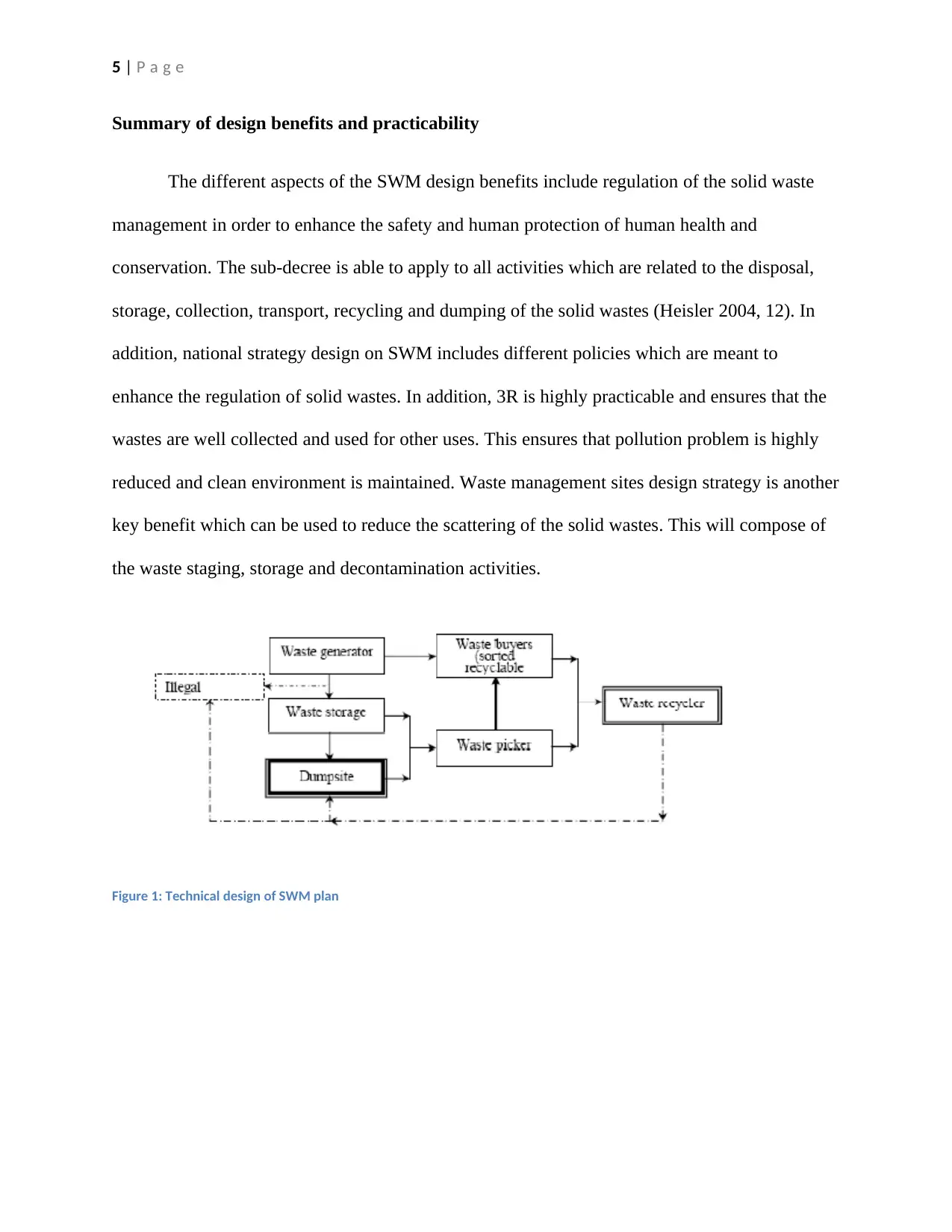
5 | P a g e
Summary of design benefits and practicability
The different aspects of the SWM design benefits include regulation of the solid waste
management in order to enhance the safety and human protection of human health and
conservation. The sub-decree is able to apply to all activities which are related to the disposal,
storage, collection, transport, recycling and dumping of the solid wastes (Heisler 2004, 12). In
addition, national strategy design on SWM includes different policies which are meant to
enhance the regulation of solid wastes. In addition, 3R is highly practicable and ensures that the
wastes are well collected and used for other uses. This ensures that pollution problem is highly
reduced and clean environment is maintained. Waste management sites design strategy is another
key benefit which can be used to reduce the scattering of the solid wastes. This will compose of
the waste staging, storage and decontamination activities.
Figure 1: Technical design of SWM plan
Summary of design benefits and practicability
The different aspects of the SWM design benefits include regulation of the solid waste
management in order to enhance the safety and human protection of human health and
conservation. The sub-decree is able to apply to all activities which are related to the disposal,
storage, collection, transport, recycling and dumping of the solid wastes (Heisler 2004, 12). In
addition, national strategy design on SWM includes different policies which are meant to
enhance the regulation of solid wastes. In addition, 3R is highly practicable and ensures that the
wastes are well collected and used for other uses. This ensures that pollution problem is highly
reduced and clean environment is maintained. Waste management sites design strategy is another
key benefit which can be used to reduce the scattering of the solid wastes. This will compose of
the waste staging, storage and decontamination activities.
Figure 1: Technical design of SWM plan
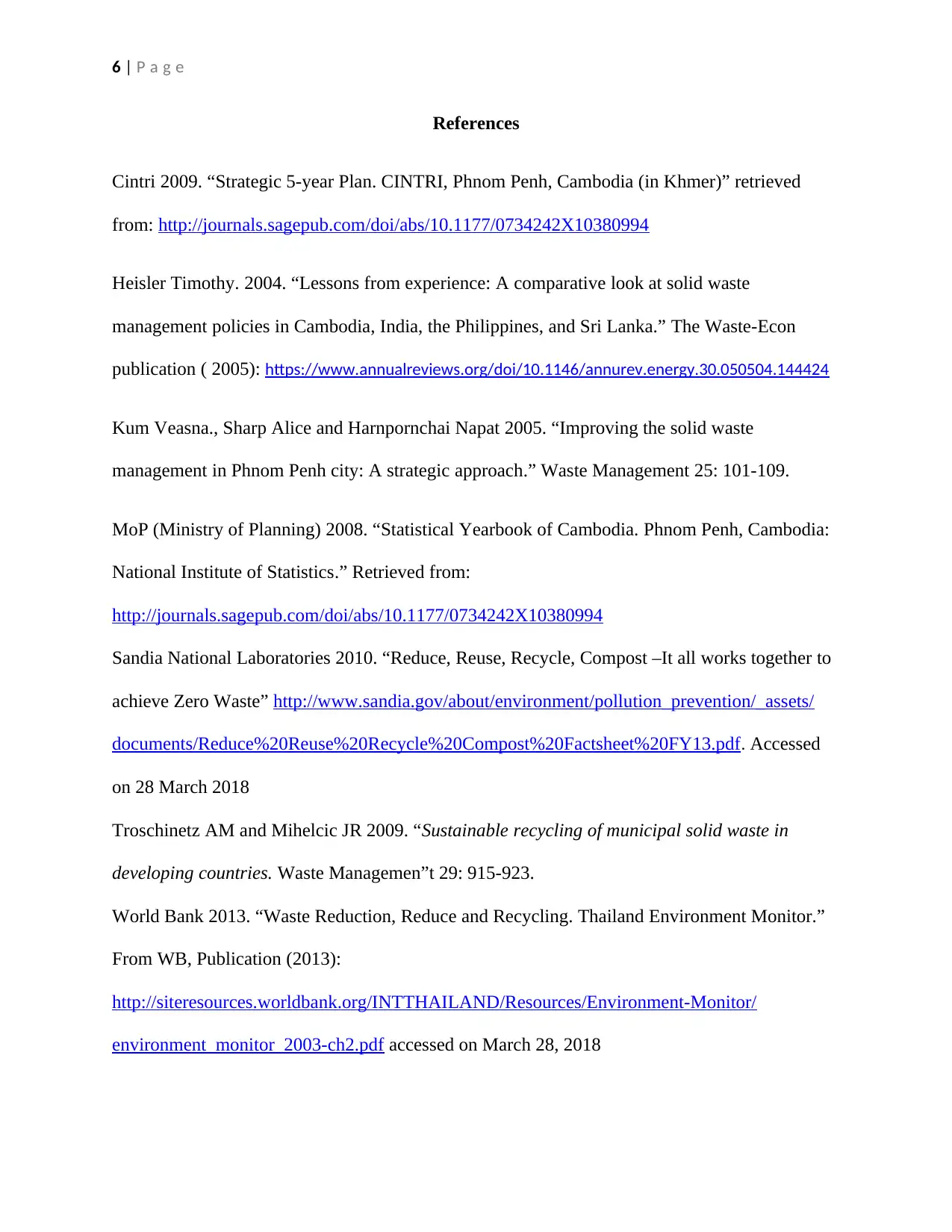
6 | P a g e
References
Cintri 2009. “Strategic 5-year Plan. CINTRI, Phnom Penh, Cambodia (in Khmer)” retrieved
from: http://journals.sagepub.com/doi/abs/10.1177/0734242X10380994
Heisler Timothy. 2004. “Lessons from experience: A comparative look at solid waste
management policies in Cambodia, India, the Philippines, and Sri Lanka.” The Waste-Econ
publication ( 2005): https://www.annualreviews.org/doi/10.1146/annurev.energy.30.050504.144424
Kum Veasna., Sharp Alice and Harnpornchai Napat 2005. “Improving the solid waste
management in Phnom Penh city: A strategic approach.” Waste Management 25: 101-109.
MoP (Ministry of Planning) 2008. “Statistical Yearbook of Cambodia. Phnom Penh, Cambodia:
National Institute of Statistics.” Retrieved from:
http://journals.sagepub.com/doi/abs/10.1177/0734242X10380994
Sandia National Laboratories 2010. “Reduce, Reuse, Recycle, Compost –It all works together to
achieve Zero Waste” http://www.sandia.gov/about/environment/pollution_prevention/_assets/
documents/Reduce%20Reuse%20Recycle%20Compost%20Factsheet%20FY13.pdf. Accessed
on 28 March 2018
Troschinetz AM and Mihelcic JR 2009. “Sustainable recycling of municipal solid waste in
developing countries. Waste Managemen”t 29: 915-923.
World Bank 2013. “Waste Reduction, Reduce and Recycling. Thailand Environment Monitor.”
From WB, Publication (2013):
http://siteresources.worldbank.org/INTTHAILAND/Resources/Environment-Monitor/
environment_monitor_2003-ch2.pdf accessed on March 28, 2018
References
Cintri 2009. “Strategic 5-year Plan. CINTRI, Phnom Penh, Cambodia (in Khmer)” retrieved
from: http://journals.sagepub.com/doi/abs/10.1177/0734242X10380994
Heisler Timothy. 2004. “Lessons from experience: A comparative look at solid waste
management policies in Cambodia, India, the Philippines, and Sri Lanka.” The Waste-Econ
publication ( 2005): https://www.annualreviews.org/doi/10.1146/annurev.energy.30.050504.144424
Kum Veasna., Sharp Alice and Harnpornchai Napat 2005. “Improving the solid waste
management in Phnom Penh city: A strategic approach.” Waste Management 25: 101-109.
MoP (Ministry of Planning) 2008. “Statistical Yearbook of Cambodia. Phnom Penh, Cambodia:
National Institute of Statistics.” Retrieved from:
http://journals.sagepub.com/doi/abs/10.1177/0734242X10380994
Sandia National Laboratories 2010. “Reduce, Reuse, Recycle, Compost –It all works together to
achieve Zero Waste” http://www.sandia.gov/about/environment/pollution_prevention/_assets/
documents/Reduce%20Reuse%20Recycle%20Compost%20Factsheet%20FY13.pdf. Accessed
on 28 March 2018
Troschinetz AM and Mihelcic JR 2009. “Sustainable recycling of municipal solid waste in
developing countries. Waste Managemen”t 29: 915-923.
World Bank 2013. “Waste Reduction, Reduce and Recycling. Thailand Environment Monitor.”
From WB, Publication (2013):
http://siteresources.worldbank.org/INTTHAILAND/Resources/Environment-Monitor/
environment_monitor_2003-ch2.pdf accessed on March 28, 2018
⊘ This is a preview!⊘
Do you want full access?
Subscribe today to unlock all pages.

Trusted by 1+ million students worldwide
1 out of 6
Related Documents
Your All-in-One AI-Powered Toolkit for Academic Success.
+13062052269
info@desklib.com
Available 24*7 on WhatsApp / Email
![[object Object]](/_next/static/media/star-bottom.7253800d.svg)
Unlock your academic potential
Copyright © 2020–2025 A2Z Services. All Rights Reserved. Developed and managed by ZUCOL.





